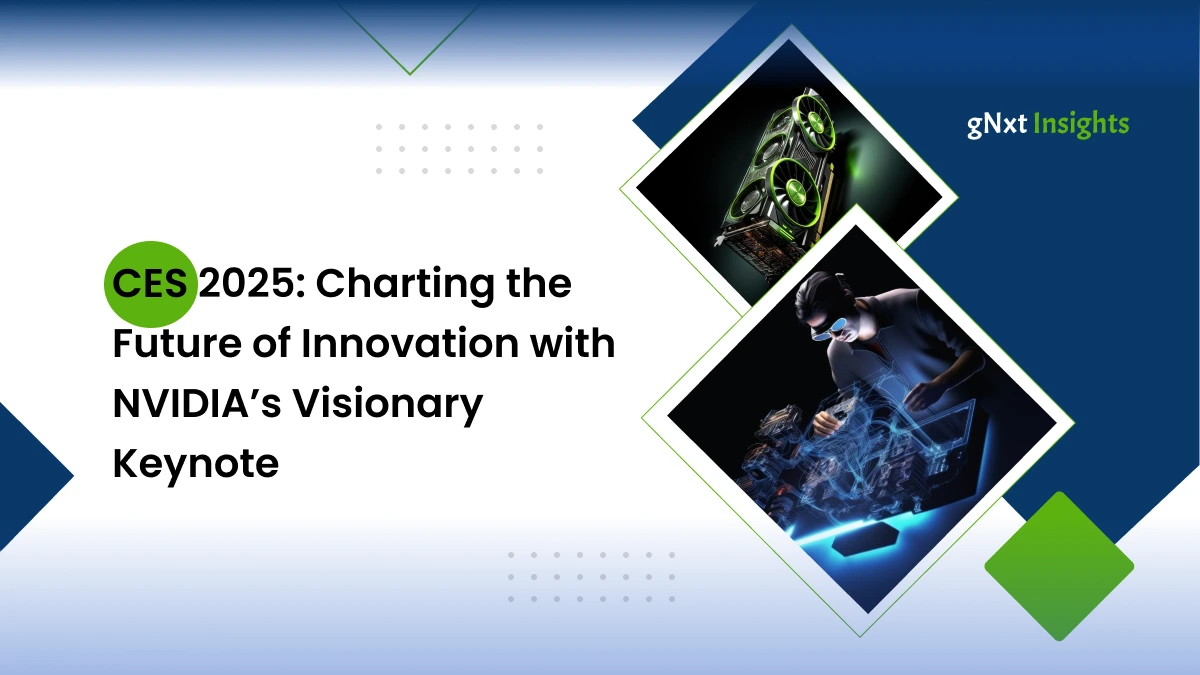- January 8, 2025
- by Anoop Kumar
CES 2025: Charting the Future of Innovation with NVIDIA’s Visionary Keynote
The Consumer Electronics Show (CES) has long been synonymous with innovation, offering a global stage where groundbreaking technologies are unveiled. CES 2025 upheld this legacy, showcasing the transformative potential of artificial intelligence (AI), digital transformation, and cutting-edge hardware. At the center of this year’s event was NVIDIA’s keynote, delivered by its Founder and CEO, Jensen Huang, who painted a compelling picture of the future shaped by AI.
From the unveiling of the RTX Blackwell GPUs to the transformative role of AI tokens, NVIDIA’s vision was a masterclass in technological leadership, marking a pivotal moment for industries across the globe.
AI Tokens: Redefining Intelligence
AI tokens were one of the most intriguing concepts introduced at CES 2025. These tokens act as the building blocks of artificial intelligence, enabling machines to interpret and generate meaningful outputs from complex inputs like words, images, and videos.
Key advancements in AI tokens include:
- Enhanced Robotics: Tokens empower robots to learn human behaviors and adapt to dynamic environments, fostering more intuitive interactions between humans and machines.
- Data Transformation: They facilitate the conversion of raw data into actionable insights, driving precision in sectors such as logistics, healthcare, and manufacturing.
This leap in AI capability represents a transformative step forward, where machines can better understand and interact with the physical and digital world.
NVIDIA’s Legacy of Innovation
NVIDIA’s journey, starting with the launch of the first programmable GPU in 1999, has been one of relentless innovation. Over the years, the company has reshaped industries by bridging the gap between hardware and AI.
Highlights from the keynote included:
- CUDA Evolution: NVIDIA’s CUDA platform revolutionized how developers utilize GPUs, catalyzing advancements in AI and machine learning.
- Generative and Agentic AI: The transition from perception-based models to AI systems capable of reasoning, planning, and executing autonomously marks a new chapter in AI evolution.
- Transformers: Since Google’s introduction of the Transformer model in 2018, AI has advanced exponentially. NVIDIA’s work in this domain enables machines to process diverse data modalities seamlessly, unlocking potential across industries.
RTX 5000 GPUs: A Performance Revolution
NVIDIA’s announcement of the RTX Blackwell family of GPUs was another highlight, setting a new benchmark for processing power. These GPUs are designed to handle the most demanding AI workloads, from generative AI models to real-time gaming applications.
Key features include:
- Unprecedented Speed and Efficiency: The RTX Blackwell GPUs deliver unparalleled computational power, accelerating AI model training and inference.
- Democratization of AI: By enhancing accessibility, these GPUs empower industries and individuals alike to leverage AI in innovative ways.
The Emergence of Physical and Agentic AI
The future of AI extends beyond data processing to interaction with the physical world. NVIDIA’s work on physical AI focuses on robotics systems that understand and operate within real-world environments.
- Cosmos Platform: A foundation for building AI systems that comprehend physical principles, paving the way for advanced robotics.
- Agentic AI: AI models capable of perceiving, reasoning, and executing tasks autonomously, heralding a new era in automation.
These innovations are set to revolutionize fields such as manufacturing, logistics, and healthcare, where intelligent systems can perform complex tasks with minimal human intervention.
Transforming Industries Through AI
NVIDIA’s keynote also underscored its impact on various sectors:
- Warehouse Automation: Collaborations with companies like Keon are driving advancements in logistics using AI and digital twin technology.
- Autonomous Vehicles: NVIDIA’s processors, such as Thor, are enhancing safety and efficiency in self-driving systems.
- Gaming and Entertainment: Integrating AI into gaming, such as real-time ray tracing, is redefining the consumer experience.
The Future Through the Lens of gNxt Systems
As a leader in digital transformation, gNxt Systems views the advancements showcased at CES 2025 as a call to action for industries to rethink their approach to technology. AI is no longer an abstract concept; it is a transformative tool that is redefining how businesses operate, innovate, and compete.
From AI-driven automation to the integration of intelligent systems, gNxt Systems is committed to empowering businesses with the tools they need to thrive in an AI-first world. CES 2025 has reinforced our belief in innovation as the ultimate driver of progress, and we are excited to be part of this global transformation.
Conclusion: A Future Fueled by Innovation
CES 2025 and NVIDIA’s keynote have set the tone for a future where technology is more intelligent, accessible, and impactful. From AI tokens to the RTX 5000 GPUs, the advancements unveiled are not just milestones; they are catalysts for a new era of possibilities.
As industries across the globe adapt to this paradigm shift, the question is not whether AI will change the world—it already is—but how quickly organizations can harness its potential to lead the way.
Read this blog by gNxt Systems, this might interest you : How RPA Is Shaping the Future of Consumer Electronics at CES 2025
About Author

CEO at gNxt Systems
With 25+ years of expertise, Mr. Anoop Jain delivers complex projects, driving innovation through IT strategies and inspiring teams to achieve milestones in a competitive, technology-driven landscape.

